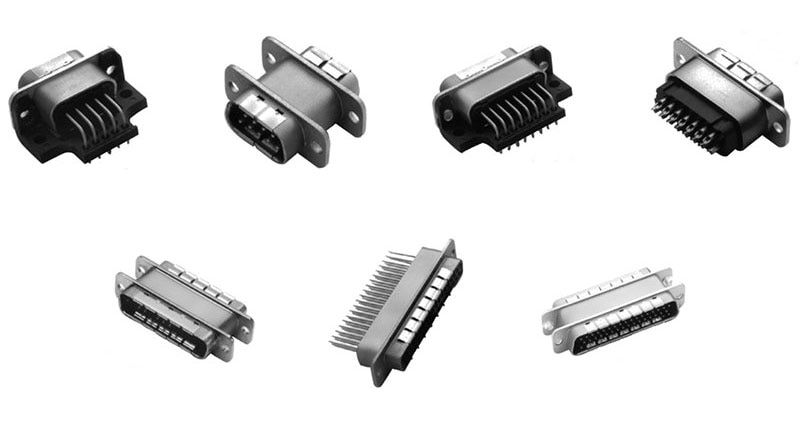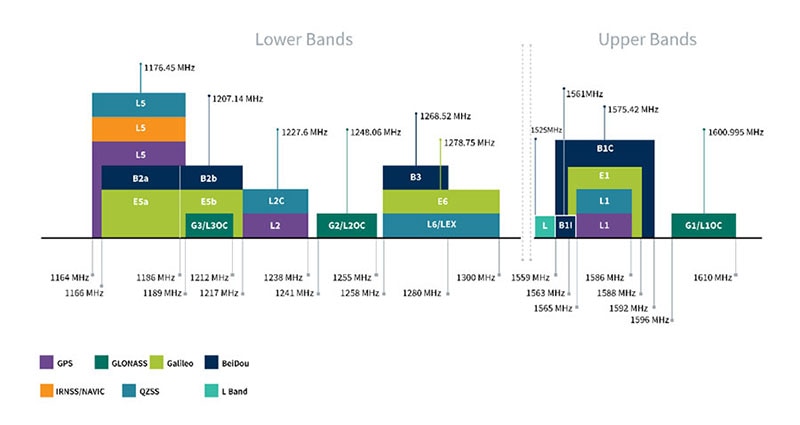The Yagi Antenna: Simple, Flexible and Great for DIYers, or to Buy Off the Shelf
Antennas and their configurations are available in a bewildering number of basic types—and variations within those types—to meet the needs of diverse applications. They can be as simple as a long-wire antenna, complex multiband arrays, or even a multiple-input/multiple-output (MIMO) arrangement.
Within this huge set of available antennas, there’s one that has long been a favorite among do-it-yourself (DIY) enthusiasts as well as commercial designers: the Yagi antenna (or more correctly, the Yagi-Uda antenna) (Figure 1).
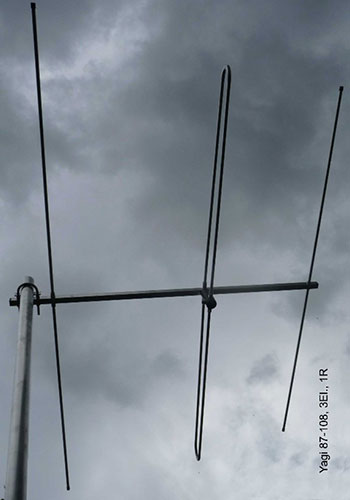 Figure 1: The basic Yagi antenna is a three-element antenna widely used in commercial, residential, and military applications and is often seen on rooftops or masts. (Image source: EuroCaster/Denmark)
Figure 1: The basic Yagi antenna is a three-element antenna widely used in commercial, residential, and military applications and is often seen on rooftops or masts. (Image source: EuroCaster/Denmark)
Why are Yagi antennas so popular?
There are many reasons for the Yagi antenna’s popularity:
- It is easy to calculate the necessary dimensions for the antenna, even though the underlying electromagnetic analysis is complicated.
- Any adjustments to these dimensions to accommodate practical issues such as the thickness of the elements and end-fringe effects are well known and can be factored into the sizing analysis.
- It is easy to build and is compatible with DIY projects.
- It is fairly easy to make a rugged version for outdoors using standard pipes and fittings that are available at a home supply store.
- They are of modest size for the performance they offer.
- They have a simple, single feed point with a mostly resistive impedance, easing matching to the transmission line if needed.
- They offer multiple degrees of freedom in terms of adjustments and are easy to modify in-house or in the field with respect to gain, directivity, bandwidth, side lobes, and other factors (within reasonable limits).
- The basic design offers good gain (8 to 10 decibels (dB) typical), usually referenced to isotropic (dBi) and high front-to-back ratio (10 to 20 dB, typical), a modest bandwidth (10 to 20% of center), and there are ways to improve these numbers.
- They can be designed and built to operate over a wide range of frequencies, and many commercial units are available for the 30 megahertz (MHz) to 3 gigahertz (GHz) range.
- They are easily scaled in their construction to provide versions that can handle higher power, into the hundreds of watts or more.
The story of the Yagi antenna
The Yagi antenna was developed in 1926 in Japan when Prof. Shintaro Uda presented the theory of this antenna in a Japanese journal. It received wide attention when an English translation was published soon after by Prof. Hidetsugu Yagi in the Proceedings of the Imperial Academy (Projector of the Sharpest Beam of Electric Waves), which explains why Yagi’s name is most closely associated with it.
In the days before cable TV and Internet streaming, the only option to receive a TV signal was as an over-the-air (OTA) RF signal using a physical antenna. If you were more than around 10 or 20 miles from the TV transmitter, depending on the power of the transmitter and the specifics of your location, you needed an antenna with higher gain than a simple folded dipole could offer, and the Yagi was the most common choice for this role.
These broadcast TV Yagi antennas were a standard item in almost any electronics, appliance, or hardware store and still are to some extent. OTA TV viewers who wanted to receive signals from transmitters located at different headings from their house might even add hand-operated or motorized mechanisms to rotate the Yagi towards the transmitter of interest.
Many houses in older areas still have their Yagi antennas in place—even if no longer used—attached to the chimney or a separate mast. Ironically, with the “cord-cutting” trend, interest in OTA TV has revived, and antenna sales of all types (including the Yagi) are increasing.
Beyond the OTA TV application, the Yagi is widely used in direction finding, amateur radio, military systems, and applications where high directivity, forward gain, high forward/backward ratio, and minimal side lobes are important.
The basics of Yagi antenna operation
The simplest Yagi antenna consists of three elements arranged along a support beam, which is usually metal (Figure 2). Only the center element is electrically connected (designated as the “driven” element), and it is either a simple center-fed, half-wave dipole, or a folded-dipole antenna. Behind the driven element is an insulated, somewhat longer reflector element; in front of it is a shorter, insulated “director” element.
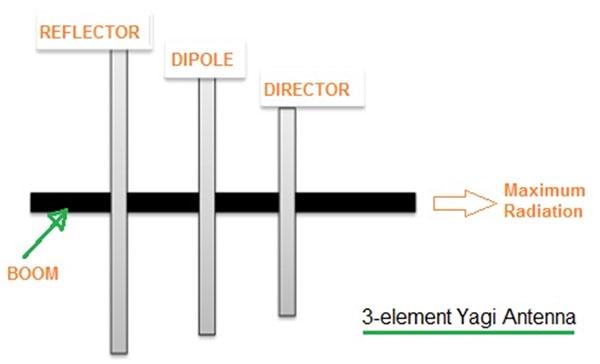 Figure 2: The basic Yagi antenna has three elements: a driven (active) dipole element with a passive reflector behind it and a passive director in front of it, all mounted on a single boom. (Image source: RFWireless-World)
Figure 2: The basic Yagi antenna has three elements: a driven (active) dipole element with a passive reflector behind it and a passive director in front of it, all mounted on a single boom. (Image source: RFWireless-World)
The reflector and director are sometimes referred to as “parasitic” elements, in contrast to the active, driven element. However, unlike the unwanted, undesirable parasitics that adversely affect the performance of components in their circuits, these parasitics are critical to the antenna function. The operating principle is based on “tuning” of the reflector and director elements such that they deliberately distort the electromagnetic (EM) field of the driven element.
The reflector is sized so it appears inductive in the bandwidth of interest. The induced EM currents in the driven element are then shifted in phase with respect to the reflector element so they reflect the power away from the parasitic element. This causes the antenna to radiate more RF power in the direction opposite to the parasitic element.
The reflector can be made inductive by adding a discrete coil, but in practice, it is almost always done the simpler and cheaper way: making the reflector longer than the driven element. A standard rule of thumb is to make it 5% longer than the driven element.
In contrast, by making the parasitic element capacitive, the induced currents are shifted in phase, so they direct the power radiated by the whole antenna in the direction of that element. Again, this can be done with a discrete capacitor, but it is almost always done by making it about 5% shorter than the driven element.
The spacing between the driven and passive elements is also critical. As a starting point, spacing between the driven element and the reflector ranges from 0.23 wavelengths (λ) to 0.35 λ, while spacing between the driven element and the director is 0.125 λ to 0.15 λ. The result is a radiation pattern with high directivity and front/back ratio, as well as modest side lobes (Figure 3).
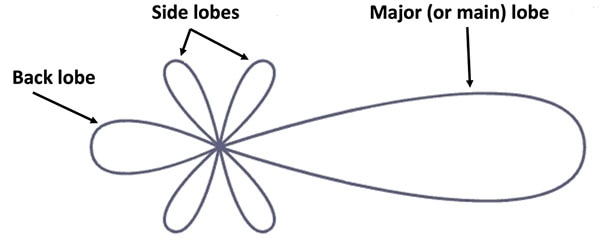 Figure 3: The generic radiation pattern of the simple Yagi shows high directivity and front/back ratio along with modest side lobes. (Image source: Electronics-Club)
Figure 3: The generic radiation pattern of the simple Yagi shows high directivity and front/back ratio along with modest side lobes. (Image source: Electronics-Club)
This basic Yagi appears as a balanced transmission line with a resistive impedance of between 10 ohms (Ω) and 40 Ω, so an impedance-matching circuit is needed. The antenna can also be driven by an impedance matching balun, which also transforms an unbalanced coaxial transmission line into a balanced one.
Yagi flexibility
As you can see from the basic arrangement of the Yagi antenna, it offers many degrees of freedom for adjustments. By changing lengths and diameters of the driven and parasitic elements, as well as their spacing, the designer can vary and trade-off antenna parameters of directivity, gain, front/back ratio, bandwidth, and side lobes, just to mention a few.
The flexibility of the Yagi goes beyond these changes, as the Yagi is not limited to just three elements. By adding more director elements—which get shorter and shorter as they get further in front of the driven element—the directivity of the antenna can be increased, and the side lobes can be decreased (Figure 4).
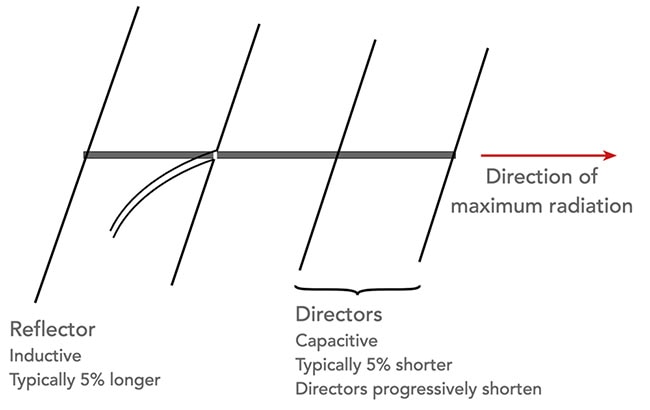 Figure 4: By adding additional passive director elements on a lengthened boom, the Yagi’s directivity and front/back ratio can be increased while side lobes are decreased. (Image source: Electronics-Notes)
Figure 4: By adding additional passive director elements on a lengthened boom, the Yagi’s directivity and front/back ratio can be increased while side lobes are decreased. (Image source: Electronics-Notes)
The spacing between these additional director elements is also a fractional wavelength, offering another parameter that can be adjusted to further tune the Yagi performance to fit the application. Some Yagi antennas have half a dozen or more director elements (Figure 5). Adding these additional elements increases the overall length of the main support but has little impact on complexity.
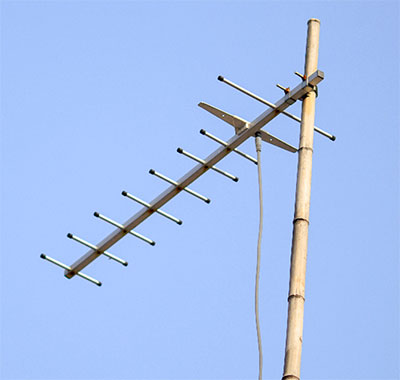 Figure 5: Adding more directors extends the length of the boom but has minimal impact on construction complexity, as seen by this Yagi antenna with seven directors. (Image source: TreLink Communication Co., Ltd.)
Figure 5: Adding more directors extends the length of the boom but has minimal impact on construction complexity, as seen by this Yagi antenna with seven directors. (Image source: TreLink Communication Co., Ltd.)
Available Yagis
Standard Yagi units are available for many parts of the spectrum in addition to those designed expressly for OTA TV in the old analog bands or the newer digital ones. For example, Antenna Technologies Limited Company’s 220-6H-MK is a six-element (one driven, one reflector, four directors) Yagi antenna centered at 220 MHz with a 3 dB bandwidth of 215 MHz to 225 MHz (Figure 6).
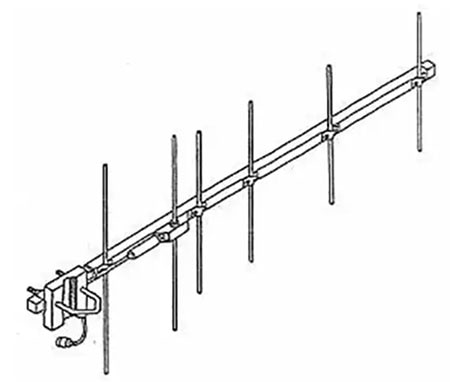 Figure 6: The 220-6H-MK Yagi antenna has a 3 dB bandwidth of 215 MHz to 225 MHz and comprises one driven, one reflector, and four director elements. (Image source: Antenna Technologies Limited Company)
Figure 6: The 220-6H-MK Yagi antenna has a 3 dB bandwidth of 215 MHz to 225 MHz and comprises one driven, one reflector, and four director elements. (Image source: Antenna Technologies Limited Company)
This heavy-duty antenna weighs just 4.25 pounds (1.9 kilograms), features a gain of 9 dBi, a front/back ratio of 15 dB, and has a boom length of 5 feet (1.5 meters). It presents a wind surface area of just 0.67 foot2 (0.06 meter2), allowing it to withstand winds of up to 125 miles/hour (200 km/hr).
For higher frequencies, the quad-band Oscar 3A from Siretta Ltd. provides coverage at 850, 900, 1800, and 1900 MHz center frequencies for GSM/GPRS applications (Figure 7). This vertically polarized antenna can handle up to 200 watts and features 11 dBi gain with a voltage standing wave ratio (VSWR) below 1.6 over its range. It measures 570 millimeters (mm) long × 180 mm wide × 36 mm high and comes with an FME male connector as well as a universal clamp for use on standard antenna poles (Figure 7).
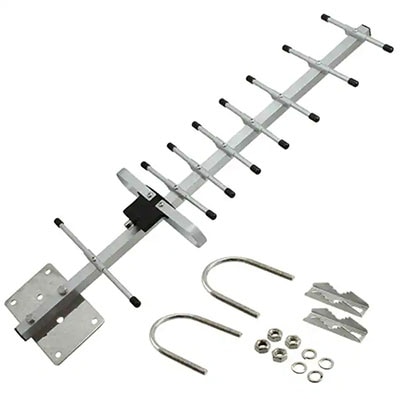 Figure 7: The Oscar 3A provides coverage at 850, 900, 1800, and 1900 MHz center frequencies and can handle up to 200 watts while offering 11 dBi gain with a VSWR below 1.6; it comes with basic mounting hardware to attach to a mast. (Image source: Siretta Ltd.)
Figure 7: The Oscar 3A provides coverage at 850, 900, 1800, and 1900 MHz center frequencies and can handle up to 200 watts while offering 11 dBi gain with a VSWR below 1.6; it comes with basic mounting hardware to attach to a mast. (Image source: Siretta Ltd.)
Conclusion
At almost 100 years old, the Yagi-Uda antenna is still widely used as it is one of the most flexible, versatile, and adjustable antenna arrangements. It is well-suited for applications where high gain, high directivity, high front/back ratio, and low side lobes are needed. This simple-looking antenna is available as a standard item for many frequency bands from companies such as Antenna Technologies Company and Siretta. It can also be easily built by DIYers and adjusted as needed. Due to its popularity and history, there are thousands of available research references, ranging from highly theoretical EM analyses to hands-on build/evaluate articles.
Further Reading
1: Beyond Wires: Antennas Evolve and Adapt to Meet Demanding Wireless Requirements
https://www.digikey.com/en/blog/beyond-wires-antennas-evolve-and-adapt
2: Antennas: Design, Application, and Performance
https://www.digikey.com/en/articles/antennas-design-application-and-performance
3: Antenna Selection Depends on Many Factors
https://www.digikey.com/en/articles/antenna-selection-depends-on-many-factors
4: Understanding Antenna Specifications and Operation, Part 1
https://www.digikey.com/en/articles/understanding-antenna-specifications-and-operation
5: Understanding Antenna Specifications and Operation, Part 2
https://www.digikey.com/en/articles/understanding-antenna-specifications-and-operation-part-2

Have questions or comments? Continue the conversation on TechForum, DigiKey's online community and technical resource.
Visit TechForum






